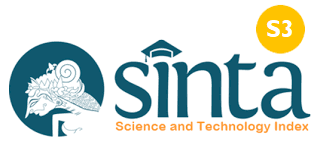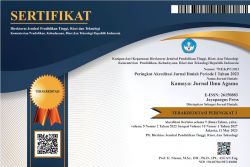Publik Sphere, Sarana Membangun Opini Masyarakat Untuk Mewujudkan Toleransi Dan Harmonisasi Dalam Perspektif Etika Hindu
DOI:
https://doi.org/10.37329/kamaya.v8i2.4225Keywords:
Public Space, Religion, ToleranceAbstract
The acceleration of technology has another impact on human understanding that is based on holy books. This condition is characterized by the existence of claims of religious truth that only glorify themselves and their groups and look down on religions and groups outside themselves so that religion becomes one of the causes of disharmony in society that often triggers inter-religious conflict. This study raises the issue of how religion has two powers that can unite and divide society and even the country. By using qualitative descriptive analysis based on literature, the researcher conducted an analysis of the meaning of religion, values of tolerance, and harmony from the perspective of Habermas's public sphere concept. Through the application of the principles of religious ethical values, it is hoped that it can contribute to efforts to realize harmony and togetherness in the era of globalization so that open and inclusive communication is established as the key to building shared understanding and reaching a fair agreement. This theory provides an overview of how public space can contribute as an essential framework in a democratic society. The conclusion of this study shows that tolerance is the main indicator for building a strong foundation in society so that it can accept the differences that exist in the public sphere. It is necessary to understand the values of tolerance in Hinduism as a form of spiritual-humanist discussion model to build religious moderation in the era of technological disruption so that public opinion refers to criticism or control carried out by society can influence state policy.
References
Assya’bani, R. (2017). Eko-Futuroloogi (Pemikiran Ziauddin Sardar). Dialogia, 15(2), 247–267.
Durkeim, E. (1961). The Elementary Forms of Religious Life. New York, NY: Collier Books.
Evangelia, F., Tubani, R., Antonia, M., Risti, E., & Eni, Y. (2024). Sollicitudo Rei Socialis: Tonggak Penting dalam Menghadapi Tantangan Globalisasi. Theos : Jurnal Pendidikan Agama Dan Teologi, 4(3), 70–75.
Gunawan, L. A. S. dan N. C. M. B. (2019). Diskursus Agama dalam Ruang Publik Menurut Jurgen Habermas. Jurnal Filsafat-Teologi, 16(2), 1–25.
Habermas, J. (1990). Discourse Ethics: Notes on a Program of Philosophical Justification. Moral Consciousness and Communicative Action. Cambridge, MA: MIT Press.
Harahap, S. (2018). Konflik dan Etnis di Indonesia. Jurnal Ilmiah Sosiologi Agama, 1(2).
Hastuti, W., Wibisono, M. Y., & Rahman, M. T. (2023). Agama dan Budaya di Pusaran Globalisasi Kontemporer. Integritas Terbuka: Peace and Interfaith Studies, 2(1), 47–58.
Ibrahim. (2010). Agama, Negara dan Ruang Publik Menurut Habermas. Jurnal Badati, 2(3), 1–10.
Ismail. (2007). Strategi Pembelajaran Agama Islam PAIKEM. Jakarta: Media Grup.
Jamalludin. (2022). Implementasi Moderasi Beragama Di Tengah Multikulturalitas Indonesia. As-Salam : Jurnal Ilmiah Ilmu-Ilmu Keislaman, 7(1).
Juniartha. (2020). Merawat Kerukunan Hidup Umat Beragama Dalam Pandangan Hindu. Widya Duta, 15(2).
Kamal, A. (2022). Politik Moderasi Beragama di Indonesia di Era Disrupsi: Menuju Dialog Spiritual-Humanis. Jurnal Pemikiran Politik Islam, 1(1), 40–57.
Kopong, K. (2021). Menalar Hubungan Agama, Pancasila Dan Negara Dalam Membangun Moderasi Beragama Di Era Disrupsi Digital. Atma Reksa: Jurnal Pastoral Dan Kateketik, 6(1), 23-32.
Latuapo, A. (2022). Masa Depan Pendidikan Agama Dan Tantangan Pluralisme Agama Dalam Ruang Publik Global. Edusaintek : Jurnal Pendidikan, Sains Dan Teknologi, 9(1), 135–155.
Marta, B. (2020). Konflik Agama dan Krisis Intoleransi: Tantangan atau Mimpi Buruk Keberagamaan Indonesia?. Depok: Pusat Studi Kemanusiaan Dan Pembangunan.
Muhtadi, A. S. (2019). Komunikasi lintas agama: Mencari solusi konflik agama. Dalam Conference Proceeding ICONIMAD 2019 (Vol. 275, No. 1, hlm. 274–300).
Nadra, I. N. (2022). Kepemimpinan Hindu Dalam Membangun Manusia Seutuhnya. Kamaya: Jurnal Ilmu Agama, 5(3), 155-166.
Nugraha. (2008). Wawasan multikultural. Bandung: Balai Diklat Keagamaan (BDK) Bandung.
Printed, I. (2022). Islam dalam globalisasi: Pengembangan nalar kritis dalam ilmu keislaman kontemporer. Madinah: Jurnal Studi Islam, 9(2), 331–346.
Radhakrishnan, S. (1953). The principal Upaniṣads (Vol. I). London: George Allen & Unwin Ltd.
Saifuddin, L. H. (2019). Moderasi beragama. Jakarta: Badan Litbang dan Diklat Kementerian Agama RI.
Warrier, A. (1953). Maha Upanisad (Translatioan). Chenai: The Theosophical Publishing House.
Yanuar, H. F., Nurhakim, A. L., Rahmawati, I. A., & Asbari, M. (2023). Social cultivator: Tantangan untuk konsisten pada toleransi dan empati. Literaksi: Jurnal Manajemen Pendidikan, 1(1), 45–49.
Zulfikar, F. (2023, Januari 26). 10 negara dengan pengguna internet tertinggi di dunia, Indonesia nomor berapa? detikEdu. https://www.detik.com/edu/detikpedia/d-6502474/10-negara-dengan-pengguna-internet-tertinggi-di-dunia-indonesia-nomor-berapa
Downloads
Published
How to Cite
Issue
Section
License
Copyright (c) 2025 Kamaya: Jurnal Ilmu Agama

This work is licensed under a Creative Commons Attribution-ShareAlike 4.0 International License.
An author who publishes in the Kamaya : Jurnal Ilmu Agama agrees to the following terms:
- Author retains the copyright and grants the journal the right of first publication of the work simultaneously licensed under the Creative Commons Attribution-ShareAlike 4.0 License that allows others to share the work with an acknowledgement of the work's authorship and initial publication in this journal
- Author is able to enter into separate, additional contractual arrangements for the non-exclusive distribution of the journal's published version of the work (e.g., post it to an institutional repository or publish it in a book) with the acknowledgement of its initial publication in this journal.
- Author is permitted and encouraged to post his/her work online (e.g., in institutional repositories or on their website) prior to and during the submission process, as it can lead to productive exchanges, as well as earlier and greater citation of the published work (See The Effect of Open Access).
Read more about the Creative Commons Attribution-ShareAlike 4.0 Licence here: https://creativecommons.org/licenses/by-sa/4.0/.





